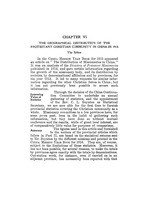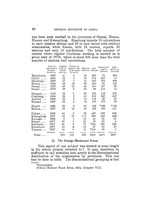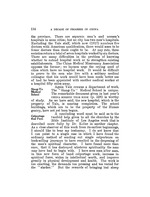|
|
|
Your search within this document for 'book' resulted in 58 matching pages.
|
| 1 |
 |
Page i
“...THE
CHINA MISSION
YEAR BOOK
1917
(EIGHTH ANNUAL ISSUE)
Edited by
THE CHINA CONTINUATION COMMITTEE
under The direction of
an editorial committee
Rev. D, MacGillivray, D.D., Chairman
Rev. C. Y. Cheng
Rev. F. D. Gamewell, Ph.D., LL.D.
D. E. Hoste, Esq.
Rev. E. C. Lobenstine
Rev. J. Walter Lcwrie, D.D.
Rev. G. F. Mosher
Rev. Frank Rawlinson
Rev. W. Hopfcyn Rees, D.D.
Rt. Rev. l. H. Roots, D.D.
Rev. Otto jScSMftze _
Rev. Arffrurl>i^Smith, P.D,
/v ....."..... '
/&/ s
editor
E. C. Ix>benstftfe\ V' / ,
vAV!1^ y/cv
Foreign Secretary, China ContinuattoQ i^otnqiittf^e ...''
SHANGHAI
THE CHRISTIAN LITERATURE SOCIETY FOR CHINA
19 17...”
|
|
| 2 |
 |
Page ii
“...THE YEAR BOOK IS SOLD
In Great Britain fay
The Religious Tract Society, 4 Bouverie St., London, E. C.
In the United States by ,
Missionary Education Movement, 156 Fifth Ave., New York City...”
|
|
| 3 |
 |
Page iii
“...sections of the field in which that work is located, but
of the movement as a whole.
The articles presented in this volume were written by sixty different
persons, living in all parts of China, and connected with many different
societies. While each chapter is complete in itself, that comprehensive
view of the work of the past year as a whole, which it is the object of
this book to present, will hardly be gained except by reading the book
through.
The China Continuation Committee is responsible for the China
Mission Year Book only in that it appoints the Editorial Committee
and the Editor. When articles in the book are the expression of the policies
or the views of the China Continuation Committee, this fact is made clear;
in all other cases, the writer of the paper is alone responsible for the
opinions expressed.
The arrangement of the material is in the main the same as last
year. The distinctive feature of this issue is a series of provincial
articles, which give a brief review of the...”
|
|
| 4 |
 |
Page iv
“... Y. Y. Tsu's article on "Native Charities of Shanghai."
The Editor desires to take this- occasion of thanking most, heartily
all those who have contributed articles to this book, and the large number
of others, including the Statistical Secretaries of the Missions, without
whose painstaking work and sympathetic co-operation, the facts here
presented could not have been secured. He also acknowledges his indebt-
edness to the members of the office staff of the China Continuation
Committee, to- the Rev. M. T. Stauffer and Miss M. Yerne McNeely for
assistance in checking statistics, preparing tables and indexing the book,
and especially to the Rev. C. L. Boynton, who this year as last, in addition
to supplying the statistics and editing che Directory of Protestant Missions
in China, has seen the China Mission Year Book through the press.
E. C. Lobenstine.
July 23rd, 1917....”
|
|
| 5 |
 |
Page xv
“...ERRATA
Page 48, Year of opening Yunnan, 1881.
Foot-note, Read China Mission Year Book,
1915, Chapter VIII.
,, 98, Chihli: Missionary societies at work, 25.
,, 110, Fukien: Total Chinese workers 3077.
,, 149, Kansu: Tota missionaries, 68.
,, 216, Shantung: missionaries societies at work in the
province, 18. Total missionaries, 453. Total
Chinese workers, 2,002. Communicant members,
32,129.
,, 258, Yunnan: Communicant members, 7,413....”
|
|
| 6 |
 |
Page 37
“...to pass the danger-
ous clause on Confucianism later. The cause of the society
is still in great danger. The society is seeking to protect
the principles of liberty for all citizens, and it does not know
whether it will succeed. Much support and influence will
still be needed before the goal is reached.*
Nothing has been said in this report about
Fea\urcsfthy arouments use(l by the society in the
e campaign. The daily papers have already
told much. It is proposed later to issue a full report in
book form. Two things should, however, be added before
this report of the work done by the society closes: (1) it has
taught wide circles of people to consider and study the
question of the nation's constitution, and (2) it has
brought religious men of all schools to meet and act
together. One further effect of this has been to lead wide
circles of thoughtful men outside the different religious
bodies, which took part in the movement, to consider the
question of the importance of religion.
*Editor's...”
|
|
| 7 |
 |
Page 45
“...CHAPTER VI
THE GEOGRAPHICAL DISTRIBUTION OF THE
PROTESTANT CHRISTIAN COMMUNITY IN CHINA IN X9J5
The Editor
In the Chinta Mission Year Book for 1915 appeared
an article on The Distribution of Missionaries in China.
It was an analysis of the Directory of Protestant Missionaries
published in 1914, and gave certain information regarding,
the growth of the missionary body, and its distribution by
societies, by denominational affiliation and by provinces, for
the year 1913. It led to many requests for similar inform
mation regarding the other Christian forces in China; but
it has not previously been possible to secure such
information.
Through the decision of the China Continua-
Valueof12 Committee to undertake an annual
Statistics gathering of statistics, and the appointment
of the Rev. C. L. Boynton as Statistical
Secretary, we are now able for the first time to furnish
provincial statistics covering the Christian community as a
whole. Missionary committees in a few provinces have, for
some...”
|
|
| 8 |
 |
Page 46
“...harbouring to the
utmost her resources and by careful and united planning.
The leaders of the missionary movement must study with
increasing care the location of every new mission station, of
every school and hospital, and of every worker. The
Church's resources, while adequate to the task, if rightly
'used, are inadequate to allow for any avoidable mistakes,
due to overlapping or to the unnecessary duplication of
institutions. The time is past when any society is justified
*In pocket at back of this book will be found a series of charts
setting forth graphically some of the data contained in these
tables....”
|
|
| 9 |
 |
Page 48
“...Szechwan.. 1877 51 8 71 *336 195 149
Kweichow. 1877 13 4 13 57 50 16
Yunnan.... 1877 10 6 12 *155 86 2
Total............61S 111 938 5519 3471 3607
II. Ths Foreign Missionary Forces
This aspect of our subject was treated at some length
in the article already referred to.t It may, therefore, be
sufficient to call attention here merely to the denominational
distribution of the missionaries by provinces. This can
best be done in table. The denominational grouping is that
incomplete.
IChina Mission Year Book, 1914, Chapter VI'll....”
|
|
| 10 |
 |
Page 66
“...each
doubled their membership in the period. Three of the socie-
ties studied showed a falling off in members, in one case 33%.
Losses in connection with the work of certain missions is
explained by the migratory character of the people, and in
other cases by the large amount of emigration. Such losses
however, may well prove the means of extending the
influence of Christianity to other parts of China and to
other lands. One church reports in 1905 a total baptized
*See charts in pocket at back of book....”
|
|
| 11 |
 |
Page 72
“...retrenchments have in some
cases been necessary, and the work has undoubtedly suffered
seriously in some regards. Nevertheless they have thus far
been allowed to remain at their stations and to continue in
their work.
Recent The decade has seen the passing of many of
Losses the most notable leaders of the missionary
forces, men of exceptional force of character
who were able to serve long years in the land of their
adoption. This is emphasized by the decease since the
publication of the last Year Book of three men whose terms
of residence in China exceeded one hundred and eighty
years. Of these Dr. W. A. P. Martin reached China in 1850,
Archdeacon E. IT. Thomson in 1859, and Dr. J. M. W.
Farnham in 1860. It was their privilege to pioneer in
evangelistic and educational work which has prospered and
borne large fruitage, and to pass on to their successors a
glorious heritage of goodwill won and leadership trained
under their influence....”
|
|
| 12 |
 |
Page 89
“... to look to the Church or mission for help in
lawsuits or similar difficulties.
Chekiang being the first province in which
Missfonar work in the interior was extensively under-
Force *Y taken, it is not surprising that it is relatively
well supplied with missionaries. The develop-
ment in this connection during the past ten years has not
been very marked. In 1906, according to Broomhall's
Chine.Empire, the total number of missionaries was 244.
By 1911 the Rev. Alex. Miller (China Mission Year Book
1912), reported a total of 313. This increase, which amounts
to about six per cent per year, would perhaps be about that of
other sections of the country. But when we compare the
figures of 1916 with those of 1911, we find an unusual and
significant fact, namely, that the net increase in foreign
missionaries in the province during the five years was only
twenty-five, making the total, according to the latest figures
available, 338. This lack of reinforcement does not, I think,
indicate waning...”
|
|
| 13 |
 |
Page 90
“...standard for Chinese
workers of all classes. When all allowances have been
made, however, we are forced to admit that our Chinese
force is not growing as the conditions demand. This is
particularly true with reference to the better trained men.
The available statistics give for 1911 a total church
membership of 18,708 and for 1916 a total of 24,228. In
each case the figures are really for the year previous.*
*It is a rather sad commentary on our business methods that the
figures for a Mission Year Book which will be in the hands of reader*
by the middle of 1917 will, so far as this province is concerned,
contain statistics collected at dates varying from March to December
1915. The easy remedy for such a condition would be for the mission!
:to collect promptly, on the blanks prepared by the Continuation Com-
mittee, statistics terminating at a fixed date each year....”
|
|
| 14 |
 |
Page 116
“...receiving
better supervision. They are better equipped and located.
The higher primary schools for boys and girls are well
managed institutions. The Anglo-Chinese colleges formerly
unrelated to the general mission education have -become
middle schools. The Fukien Christian University has a
broad base upon which to build. There are 104,830 boys
in the lower and higher primary schools and 3,838 in the
middle schools. Experiments are being made in introducing
a little vocational education. Agriculture, book-keeping,
typewriting and manual training have been introduced into
several schools....”
|
|
| 15 |
 |
Page 134
“...hospital fifty miles away.
Again Yale crowns a department of work.
Medical The Siang-Ya Medical School is unique.
School remarkable document given in last year's
china mission year book (p. 528) is worthy
of study. As we liave said, the new hospital, which is the
property of Yale, is nearing completion. The school
buildings, which are to be the property of the Hunan
gentry, have not yet been begun.
A concluding word must be said as to the
thafpa*!* twofold help given to all the churches by the
s Bible Institute of Los Angeles work that is
described more fully by Dr. Keller in another chapter.
As a close observer of this work from its earliest beginnings,
I should like to bear my testimony. I do not know that
I can point to a single case in which I have found the
ordinary method of sending out single colporteurs on
book-selling journeys to have resulted in the deepening of
the man's spiritual character. I have found more than
once, that it has destroyed whatever spirituality the man
may have had...”
|
|
| 16 |
 |
Page 146
“...which is worked at a profit. Leading missionaries
of all the missions have given of their best for the upbuild-
ing of this society, and to-day are working as directors for
its development. The depot in the Poyang Road, Hankow,
is known as the Griffith John Jubilee Building, and was
opened in the year 1912. It involved an initial expenditure
for land and building of over Taels 40,000. The Arthing-
ton Press involved in addition the expenditure of over
Taels 17,000. On the ground floor are the book rooms,
press, editorial and general offices, etc. On the two upper
floors are the residence of the general secretary, board
room, translators' room, etc. The society commenced work
in 1876 and in the first forty years, i.e., to the end of 1915,
it had put into circulation over 31,000,000 of its own books
and tracts; and had also handled some 15,000,000 books
and tracts for the Distribution Fund. During the year
1915 an amalgamation was effected with the North China
Tract Society. Hankow became...”
|
|
| 17 |
 |
Page 152
“...redoubtable Tsin-shi-Hwang-ti. Coming
down the centuries there has been a good deal of fighting
with the tribes on the borders. And in the end the Chinese
proved themselves the victors, eventually pushing their way
until they claimed and took possession of the New Domi-
nion. Yeaiiy there is a long procession of officials, exiles,
merchants, farmers, labourers, to that great province, along
the main north-western road. And along that road for
some distance travelled Marco Polo, who in the pages of
his book, describes the cities he visited.
To-day the Chinese in Kansu numbering
Consf/va/ive 7>000>00'> are a slow> conservative people.
They like the old ways. Even now the offi-
cials issue their proclamations saying the people must cut
off the queue and that girls' feet must not be bound, but
they make no difference. The Kansuite is also independent.
Education is at a discount, save in the
Education large cities. The officials, however, are
plodding away, trying to arouse the people
to a sense of the...”
|
|
| 18 |
 |
Page 232
“...encouraging to
justify more effort in that line." The method seems to be
instilling in the minds of many students a growing whole-
some respect for manual labour, but there is great need of
additional light in regard to industrial education, in order
that it may best meet the needs of mission work.
Schools for business training are found at
ScWs Weihaiwei (forty pupils) and at Chefoo (one
c 00 s hundred and eighty pupils). In the latter
school the aim is to give a good general education, together
with book-keeping, typewriting and stenography. The
graduates are filling acceptably positions in various parts, of
China.
One of the most significant changes in the
of English educational work in Shantung during recent
s years has been in the attitude toward the
teaching of the English language. Until 1908, outside of
the Anglo-Chinese School in Chefoo, the English language
had no place in the educational scheme. In that year it
was introduced in the upper classes of the School of Arts
and Science in the...”
|
|
| 19 |
 |
Page 238
“...Stations, 7.
^Missionary Societies at work in the province, 4. §TotaI Missionaries,
117. Total Chinese Workers, 334. Communicant members, 3,825.
# The year 1907 was in Shensi one of
^Mission*0*11* ecclesiastical stock-taking. It was a time of
Work* reviewing and consolidating the past, and of
preparing for expansion. A more or less
definite stage had been reached, and the turning point was
marked by the visit from England of the Revs. W. Y.
Fullerton and C. E. Wilson, the Shensi section of whose
book New China should be consulted with regard to the
progress registered up to that point. They actually wit-
nessed the baptism of the thousandth member received into
the Baptist Church. Until 1900 entrance into cities had
been extremely difficult; the work had, therefore, been al-
most entirely in villages, with a Gospel village as the centre,
^Richard. fMinchengpu Census, 1910. iAll Missionary Statistics,
1915. § Including wives....”
|
|
| 20 |
 |
Page 269
“...Societies at
work in the province, 0. §Total Missionaries, 170. Total Chinese
workers, 926. Communicant members, 20,236.
I. **Historical Sketch
For the last thirty years mission work in Manchuria
has been punctuated at intervals of about five years by such
natural or political events as floods, famines, wars, and
*Ricliard. f Minchengpu Census, 1910. iAll Missionary Statistics,
1915. § Including wives. **Chief references to conditions and work
in Manchuria in earlier issues of the China Mission Year Book :
1911, pp. 215-222; 1914, 416-428,232-239; 1915 45-47, 253-256; 1916,
90-92, 128-129, 14M43, 244-246....”
|
|
|